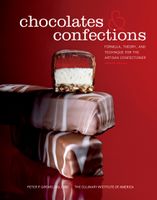Label
All
0
Clear all filters
Maple Candy
Appears in
By Peter Greweling and Culinary Institute of America
Published 2007
In earlier times, maple candy was one of the few confections available. The classic method for making it is to boil maple syrup in order to concentrate the sugar, which is primarily sucrose. After boiling, the syrup is cooled somewhat, then stirred to induce crystallization. It is then poured into molds to crystallize the rest of the way. When making maple candies by this method, timing is critical: the syrup must be poured after seeding has begun but before the crystallization process is complete. Pouring the syrup into the molds before adequate seeding has taken place produces candies with a very sugary texture. Waiting too long to pour the syrup into the molds results in a pot full of crystallized sugar. Allowing the syrup to cool prior to agitation helps create smaller sugar crystals than would be created if the syrup were stirred while it is very hot. Because maple candy contains no doctoring agents, the texture is usually somewhat coarse compared to that of fondant or fudge.
Become a Premium Member to access this page
Unlimited, ad-free access to hundreds of the world’s best cookbooks
Over 160,000 recipes with thousands more added every month
Recommended by leading chefs and food writers
Powerful search filters to match your tastes
Create collections and add reviews or private notes to any recipe
Swipe to browse each cookbook from cover-to-cover
Manage your subscription via the My Membership page
Best value
Part of
Advertisement
Related Recipes
-
-
-
-
Related Reference
-
-
-
-
Advertisement
The licensor does not allow printing of this title




